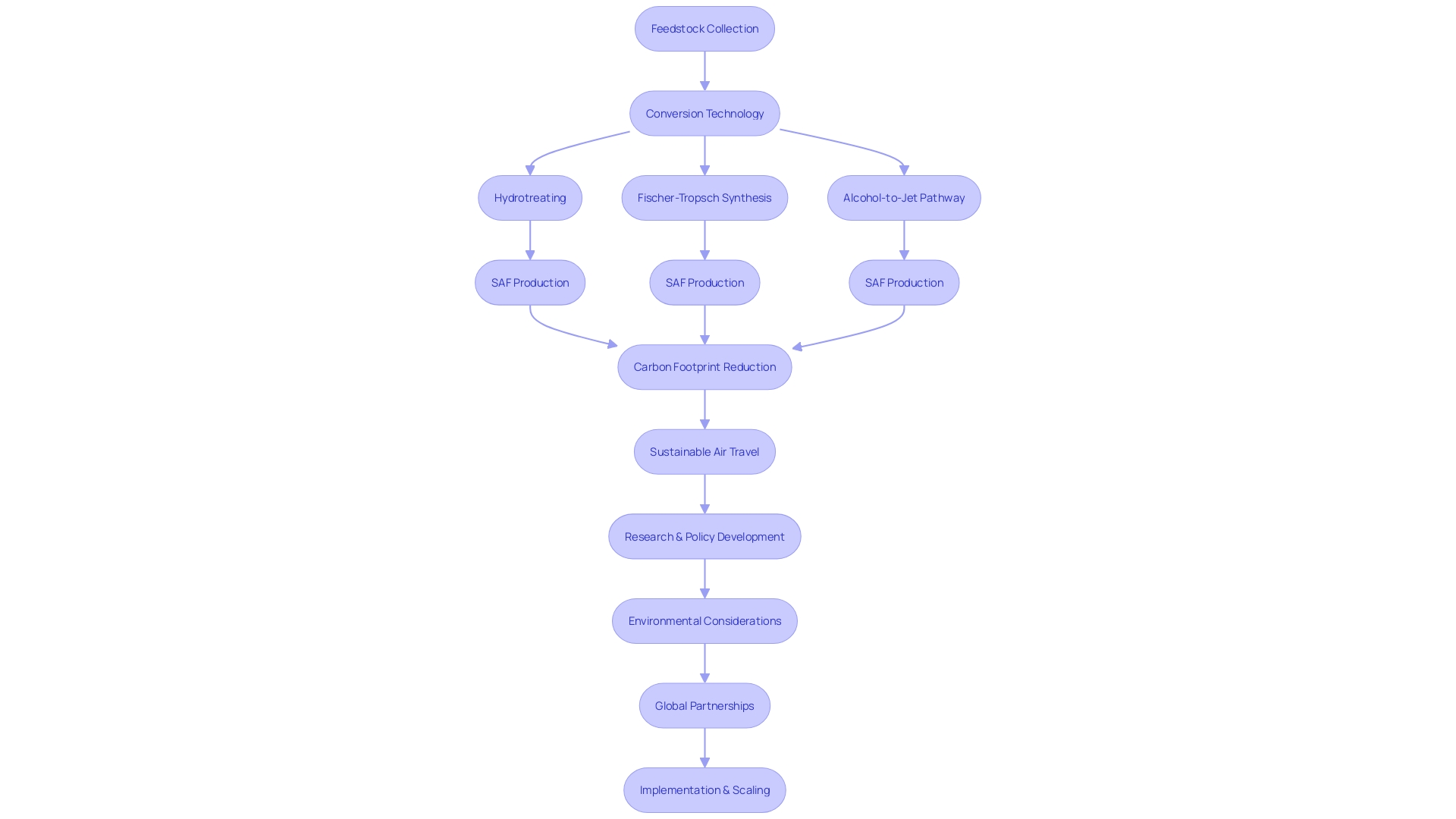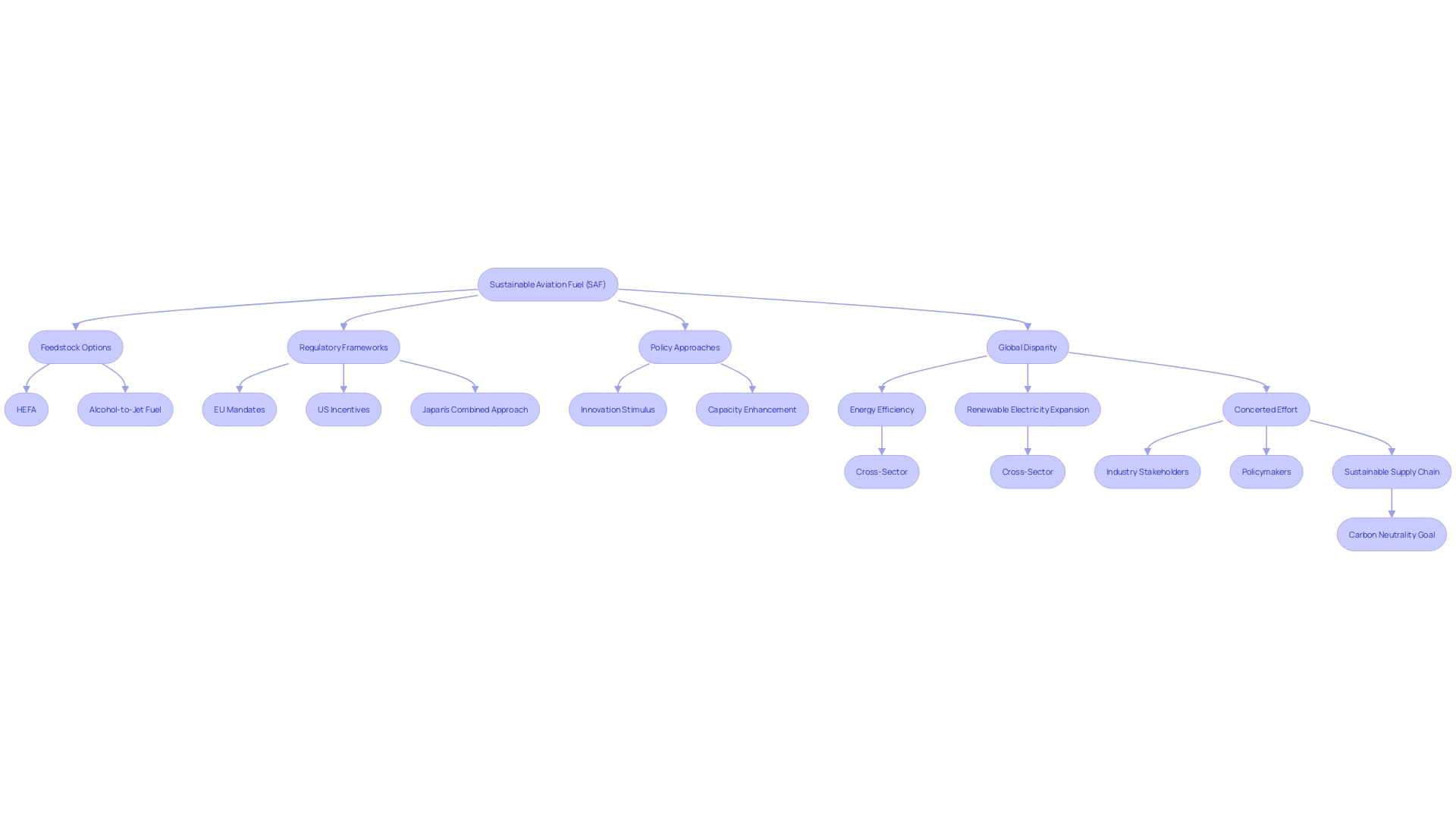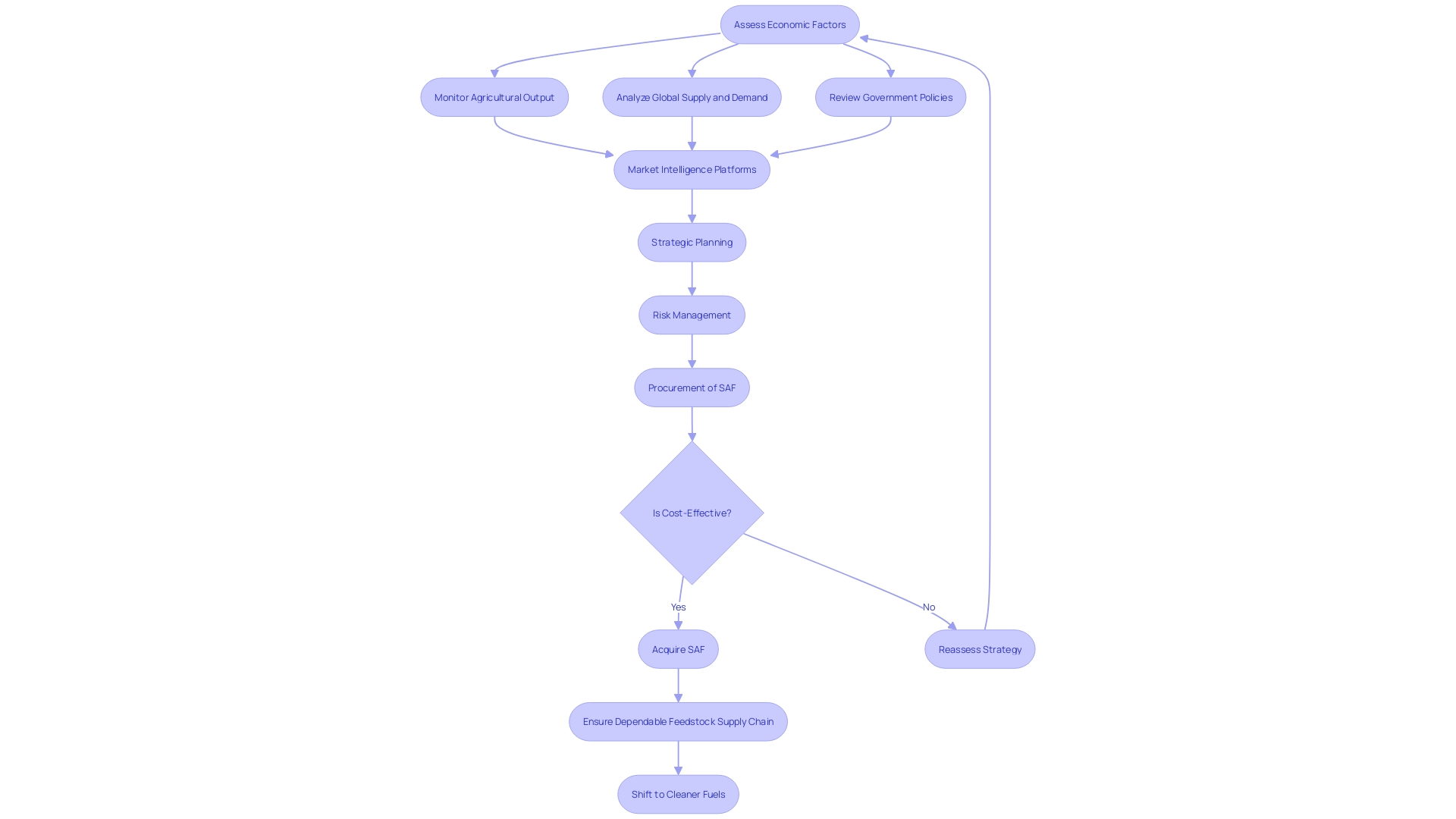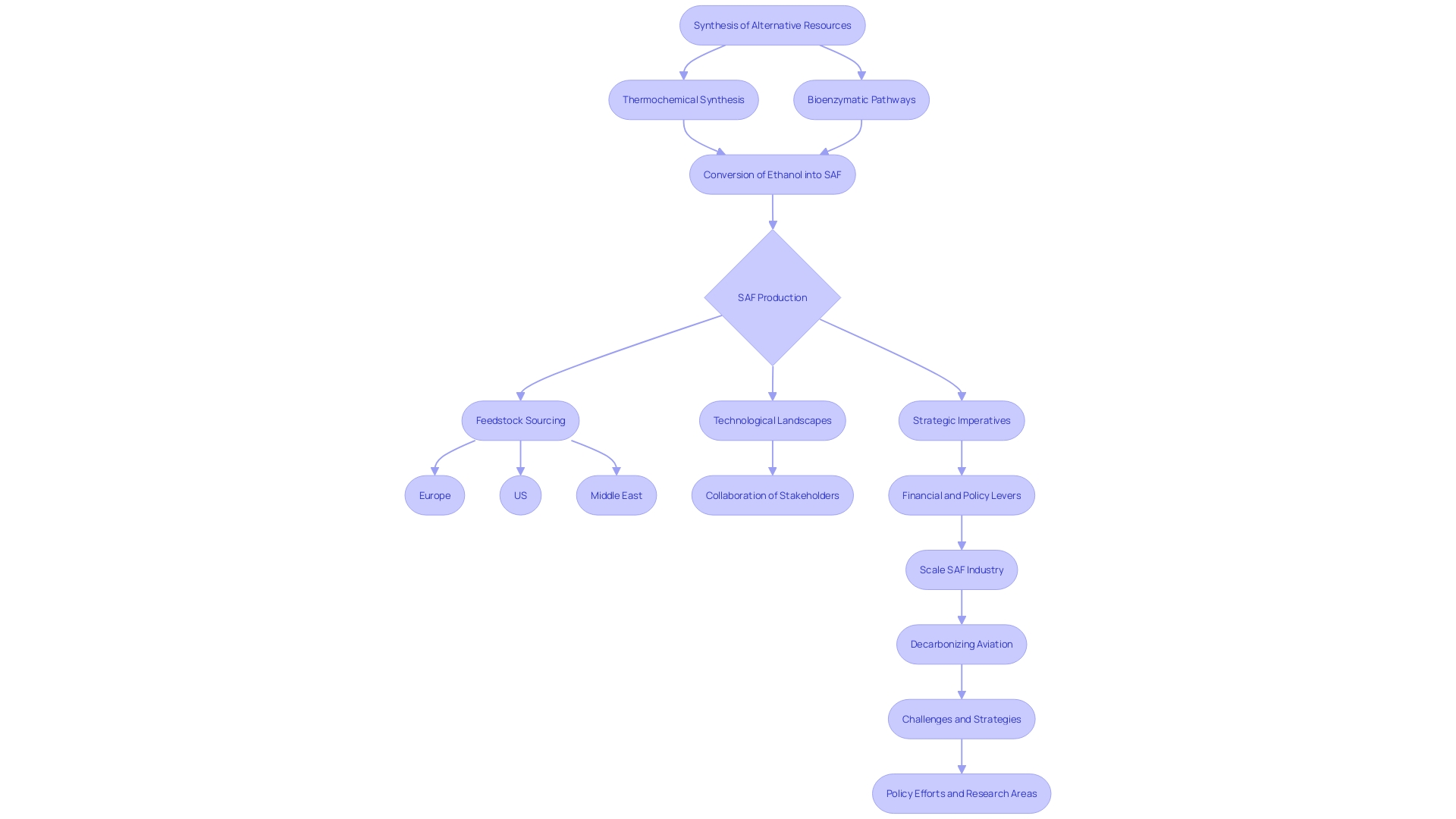Introduction
Exploring the diverse feedstocks for sustainable aviation fuel (SAF) offers a window into the future of aviation's environmental sustainability. Currently, the industry is experimenting with a variety of raw materials such as waste oils, fats, lignocellulosic biomass, and algae. Each of these presents unique opportunities to reduce aviation's carbon footprint.
However, the challenge lies in scaling up production to meet the demand for long-haul flights, which requires significant volumes of SAF. As the aviation industry aspires to reach net-zero carbon emissions by 2050, the integration of these alternative feedstocks into the fuel supply chain is critical. With companies like Virgin Atlantic pioneering the use of SAF and expanding their routes, the industry is taking confident steps towards a greener future, supported by evolving technologies and a commitment to eco-friendly innovation.
Types of Feedstocks for SAF Production
Examining the varied feedstocks for sustainable fuel for flying (SAF) provides insight into the future of the environmental sustainability of flying. Currently, the industry is experimenting with a variety of raw materials such as waste oils, fats, lignocellulosic biomass, and algae. Each of these presents unique opportunities to reduce aviation's carbon footprint. For instance, waste oils and fats are already being utilized in some flights, showcasing the practical applications of these resources. Nevertheless, the difficulty lies in expanding the manufacturing capacity to fulfill the need for long-haul flights, which necessitates substantial quantities of SAF.
Algae, with its high yield potential, could revolutionize SAF, but its commercial viability is still being tested. Lignocellulosic biomass, derived from non-food plants, also holds promise due to its abundance and sustainability. As the air travel sector aims to achieve a state of emitting no carbon by 2050, the incorporation of these substitute raw materials into the fuel distribution system is crucial. With companies like Virgin Atlantic pioneering the use of SAF and expanding their routes, the industry is taking confident steps towards a greener future, supported by evolving technologies and a commitment to eco-friendly innovation.
Technological Pathways for SAF Conversion
The creation of sustainable air travel fuel (SAF) is a complex and multifaceted process that necessitates efficient conversion of feedstocks through advanced technological pathways. Among these, hydrotreating stands out as a prevalent method, leveraging hydrogen to remove oxygen from biomass-derived oils, transforming them into paraffinic hydrocarbons suitable for air travel. Fischer-Tropsch synthesis offers another route, converting a mixture of carbon monoxide and hydrogen into liquid hydrocarbons, a process that is highly scalable and capable of producing high-quality fuels. Additionally, the alcohol-to-jet pathway is gaining traction, converting ethanol, a renewable resource, into jet fuel, as evidenced by the successful operation of LanzaJet's Freedom Pines Fuels plant in Georgia, marking a significant advancement in decarbonizing aviation.
Each conversion technology bears unique technical characteristics and environmental considerations. Hydrotreating, for instance, is recognized for its compatibility with existing refinery infrastructure, making it a convenient option for immediate scale-up. In comparison, Fischer-Tropsch synthesis is lauded for its versatility in feedstock utilization, which can include gasified biomass or even captured carbon dioxide, aligning with the overarching goal of a net-zero greenhouse gas economy as outlined in the 'Roads to Removal' report. The alcohol-to-jet process, in the meantime, showcases the innovative utilization of sustainable ethanol sources, adding to the variety of technologies required for a comprehensive approach to SAF manufacturing.
The intricacies of these conversion technologies and their developmental stages reflect the insights from Ibrahim A. Abba, a chief technologist who emphasizes the importance of pursuing multiple research tracks. This strategy ensures a broad technology portfolio, capable of addressing the varying types of crude, product outputs, and investment scales. The successful implementation of these technologies also hinges on strong internal collaborations within the industry and global partnerships, as illustrated by Virgin Atlantic's joint ventures and the collaborative efforts of Hitachi Energy to address environmental challenges.
In the end, choosing the right technology for SAF manufacturing is not only about effectiveness and expandability; it's about comprehending the complete life cycle influence and guaranteeing harmony with the wider goals of decreasing the carbon footprint of air travel. As the industry strives towards powering more flights with SAF, currently at only 0.1%, the choice of conversion technology will play a pivotal role in achieving this transition, all while maintaining a keen focus on the sustainability and economic viability of each pathway.

Challenges in Feedstock Availability and Competition
The quest for sustainable aviation fuel (SAF) is gaining momentum as the industry seeks to curb its carbon footprint. However, ensuring a steady supply of feedstock for SAF poses significant hurdles, including limited availability and intense competition from other sectors. The synthesis of fats and amino acids, particularly from oil crops with substantial environmental impacts, underscores the need for eco-friendly and scalable solutions. The manufacturing procedure itself is a reversal of combustion, where energy is harnessed to convert water and CO2 back into fuel, underscoring the technical complexity involved.
With SAF powering only 0.1% of flights, there is an urgent need to enhance manufacturing. The U.S. aviation sector, a notable emitter of transportation-related emissions, is projected to grow, further intensifying the urgency for SAF. Amidst this backdrop, the industry is exploring various technological pathways, such as Hydro-processed Esters and Fatty Acids (HEFA) and alcohol-to-jet fuels. The global strategy to expand SAF manufacturing is fragmented, with regions like the EU favoring mandates and the U.S. providing incentives, highlighting the disparate approaches to fostering innovation in this field.
Innovative ventures are crucial to overcome the challenges of SAF procurement. For instance, the surplus of soybean meal resulting from increased demand for soybean oil in SAF production prompts the need for novel applications of soybeans. Initiatives such as the Soy Innovation Challenge showcase the determination to creatively utilize this surplus, while companies like Renewable Green Composites are leading the way in utilizing agricultural products in eco-friendly plastics, providing a glimpse into the potential of diversifying the use of raw materials.
Despite its scarcity and high cost, SAF remains a cornerstone for the aviation industry's aim to achieve carbon neutrality by 2050. The importance of developing successful strategies that guarantee consistent raw material supply is not just essential for the environment but also for the industry's economic sustainability, as the responsibility of transitioning to SAF may eventually fall on consumers. The conversation continues to evolve, with stakeholders scrutinizing production figures, debating the merits of mandates versus incentives, and considering the vast land and resource requirements to meet SAF targets.
Impact of Regulatory and Policy Frameworks on Feedstock Sourcing
Regulatory and policy frameworks are crucial in shaping the sustainable fuel landscape for air travel, influencing the sourcing and availability of essential resources. With aviation accounting for a significant portion of global CO2 emissions and recognized as one of the hardest sectors to decarbonize, SAF emerges as a key decarbonization strategy. The International Civil Aviation Organization's ambition for carbon-neutral growth by 2050 underscores the urgency of developing robust regulatory environments that support this goal.
The creation of SAF is diverse, with different technological pathways and feedstock options, such as Hydro-processed Esters and Fatty Acids (HEFA) and alcohol-to-jet fuel. However, the early stage of SAF technologies and their manufacturing scales poses challenges. The debate around mandates versus incentives reflects a global disparity in approaches to amplify SAF production—while the European Union leans towards mandates, the United States favors incentives, and Japan combines both. Incentives are widely acknowledged as essential for stimulating innovation that can enhance capacities and develop new SAF pathways.
Enhancing energy efficiency across all activities remains paramount, as does the expansion of renewable electricity production. This includes not just electrification of transportation but also heating, cooling, industrial processes, and water management. A concerted effort from industry stakeholders and policymakers is needed to align and navigate the complex landscape of regulations, mandates, and incentives. This partnership will be crucial to establish a sustainable and resilient supply chain for SAF, contributing to the broader goal of carbon neutrality.

Strategies for Ensuring Sustainable Feedstock Supply Chains
Ensuring a sustainable supply chain for raw materials is a complex undertaking, and industry pioneers are implementing a variety of approaches to tackle this issue. One important strategy is the diversification of raw material sources, which reduces the risk of supply chain disruptions. For instance, companies like Danone have demonstrated the effectiveness of this strategy by collaborating with a vast network of 58,000 global farmers to reduce methane emissions, a significant climate pollutant. This initiative has highlighted the potential of systems thinking in corporate climate strategy, leveraging partnerships across research, policy, market coalitions, and supply chains to drive widespread adoption of sustainable practices.
Further improving the resilience of SAF production, collaborations with suppliers of raw materials have proven to be invaluable. A notable example is the Elite Group, which has embraced the use of SAF produced from used cooking oil. This not only aligns with their environmental, social, and governance (ESG) objectives but also contributes to reducing carbon emissions by an average of 80%, compared to conventional fuel. These collaborative efforts demonstrate how industry leaders are prioritizing environmental stewardship while simultaneously advancing their commercial objectives.
Furthermore, to guarantee traceability and accountability within the supply chain, sophisticated tracking systems for raw materials are being implemented. These systems are essential for monitoring the lifecycle of raw materials, from sourcing to final conversion into SAF. The adoption of such technologies underscores the industry's commitment to transparency and responsible management of resources. Together, these approaches not only ensure the availability of raw materials but also enhance the long-term sustainability and efficiency of the SAF sector.
Geographical and Logistical Considerations in Feedstock Procurement
The strategic acquisition and management of raw materials for Sustainable Aviation Fuel (SAF) production are crucial, given the air travel industry's objective of attaining net-zero carbon emissions by 2050. Considering the infancy of SAF technology and the aviation sector's substantial carbon footprint, it's imperative to optimize every step of the supply chain.
Geographical positioning, transportation networks, and storage capabilities greatly impact the availability and cost-effectiveness of SAF sources. Identifying strategic locations for procurement is essential, as proximity to manufacturing facilities can reduce transportation costs and associated emissions. Additionally, a strong infrastructure is needed to guarantee a steady supply of raw materials. This includes not only the physical aspects, such as well-connected roads and ports, but also dynamic simulations of infrastructure systems that can adapt to the quasi-static nature of supply chains.
Moreover, the requirement for fragrances in air travel fuel, which presently restricts the proportion of SAF that can be combined with traditional jet fuel, is being tackled by advancements in bio-derived fragrances creation. This innovation has the potential to increase the use of SAF, with successful tests of 100% SAF flights by major airlines signaling a significant shift in the industry.
However, the transition to SAF is not just about the fuel itself; it involves a comprehensive network of fueling infrastructure that must be compatible with existing aircraft fleets and airports. The challenge of modifying this infrastructure, much of which is underground, spans across cost, time, and logistics, making SAF a more practical 'drop-in' solution compared to other alternative fuels.
During this transition, the industry of flying is backed by information from entities such as NREL, which offers comprehensive energy supply curves and cost analysis, enabling well-informed choices on material procurement and logistics. The June 2024 Feed Outlook report, for example, offers critical insights into the feed markets, which are instrumental for planning and managing the SAF supply chain.
To ensure a consistent and affordable supply of SAF, it is crucial to integrate strategic geographical planning, transportation, and storage infrastructure, along with innovative production processes and comprehensive industry data. This method will not only tackle the immediate logistical challenges but also set the stage for a sustainable and decarbonized future in air travel.
Economic and Market Dynamics Affecting Feedstock Costs and Availability
The acquisition of sustainable aviation fuel (SAF) sources is a complex undertaking influenced by economic and market factors. These factors include the balance of supply and demand, competition within the marketplace, and the influence of government subsidies. For example, the interaction of supply, which involves manufacturing capabilities, with demand from consumers determines the market price. The cost must be enough to cover the expenses of producing and generate a profit, ensuring the viability of suppliers.
The competitive landscape is also crucial; companies must navigate it effectively to secure the most advantageous terms for procuring raw materials. Expert insights, like those from FCC Senior Economist Justin Shepherd, underscore the significance of monitoring agricultural output and global supply and demand trends.
In the realm of government action, initiatives such as the U.S. commitment to increase SAF production to 3 billion gallons by 2030 exemplify the role of policy in shaping the raw material market. These efforts aim to scale up the cultivation of low-input, sustainable biomass crops. The Renewable Fuel Standard (RFS) in the U.S. predominantly relies on ethanol, derived from corn, but the biodiesel and renewable diesel sectors are growing to meet the Biomass-Based Diesel (BBD) mandate.
Market intelligence platforms like Argus provide valuable data, offering transparency and trusted reference points for physical supply and derivative contracts. Their pricing knowledge, derived from 50 years of data across important commodity sectors, can inform strategic planning and risk management in SAF procurement of raw materials.
Ultimately, understanding these dynamics and maintaining a vigilant eye on market indicators and policy developments is pivotal for heads of fuel procurement. This guarantees they can adapt strategies in real-time, ensuring cost-effective and dependable feedstock supply chains, crucial for the shift to cleaner fuels.

Future Trends and Emerging Feedstocks in SAF Production
With the air travel sector's ambition to achieve net zero carbon emissions by 2050, the role of Sustainable Flight Fuel (SFF) has never been more critical. The unique attribute of SAF is its compatibility with existing aircraft engines and fuel infrastructure, enabling immediate utilization without extensive modifications. This adaptability positions SAF as a practical approach for reducing aviation's carbon footprint in the near term. The advancement of bio-based aromatics production has further expanded the potential for SAF usage, with successful tests demonstrating the viability of 100% SAF in commercial flights, including the landmark trans-Atlantic journey by Virgin Atlantic.
This change in the sector is supported by innovation, especially in the advancement of substitute raw materials. Derived from various materials, from non-food woody biomass to agricultural by-products, these innovative feedstocks are shaping the path for a more sustainable air travel industry. The utilization of these resources translates to a dual benefit: reducing emissions and diminishing the reliance on fossil fuels.
Despite the promise of SAF, current utilization in the air travel industry remains at a fraction of its potential, with only 0.1% of flights being powered by it. The challenge lies in scaling up production to meet global demand and ensuring the availability of large volumes necessary for long-haul flights. As the third largest contributor to US transportation emissions, the sector's growth trajectory indicates an urgent need for accelerated adoption of SAF.
The future of SAF procurement is a developing field, with ongoing research and technological innovations aimed at improving the environmental and economic sustainability of these fuels. Each development, such as the pioneering flight by Virgin Atlantic, marks a significant stride towards the industry's net zero aspirations. As stakeholders across the air travel system collaborate, the growing role of SAF is not just a possibility but an imperative in the journey to a more sustainable future.
Case Study: Successful Implementation of Alternative Feedstocks and Technologies
A significant development in the realm of sustainable aviation fuel (SAF) is illustrated in the case study of a pioneering facility that effectively utilized alternative resources and technological advancements. This facility, by employing chemical techniques adept at synthesizing fats and amino acids like glycine and methionine, has surmounted the complexities of feedstock synthesis. With a focus on fats, the facility taps into their simplicity for thermochemical synthesis, historically proven scalability, and minimal environmental footprint, unlike their oil crop counterparts which significantly impact land use and greenhouse gas (GHG) emissions.
The case study explores the implementation of bioenzymatic pathways for a broader spectrum of nutrients, aiming for sustainable output without compromising nutritional integrity. Amidst the backdrop of global initiatives to establish commercial-scale biorefineries, this example stands as a testament to the feasibility of reducing lifecycle GHG emissions within the transportation sector, particularly aviation—an industry that contributes notably to global CO2 emissions and faces challenges in decarbonization.
This innovative approach aligns with the dynamic international discourse on SAF creation, where the interplay of mandates and incentives sparks diverse strategies across different regions. Incentives, particularly, are deemed essential in spurring innovation and bolstering SAF pathways, including the established Hydro-processed Esters and Fatty Acids (HEFA) and the burgeoning alcohol-to-jet fuel.
In the United States, coordinated actions by important government departments aim to speed up SAF manufacturing, with ambitious goals set for the upcoming decades. The LanzaJet Freedom Pines Fuels plant in Georgia is a prime example, pioneering the conversion of ethanol into SAF. This initiative not only marks a historic moment for LanzaJet but also for the collective aviation industry in its pursuit of net-zero carbon emissions. With the industry's dependence on renewable fuel projects to achieve sustainability targets, the anticipated increase in renewable fuel manufacturing capabilityâpossibly reaching 51 million tons by 2030âindicates a strong investor interest in SAF.
This case study provides vital insights for industry stakeholders on the complexity of sustainable feedstock sourcing, the technological landscapes available for SAF production, and the strategic imperatives to navigate an industry undergoing a greener transformation. It underscores the importance of integrating sustainability with economic and technological feasibility to realize the full potential of SAF as a cornerstone in the aviation sector's environmental strategy.

Conclusion
In conclusion, exploring diverse feedstocks like waste oils, fats, lignocellulosic biomass, and algae presents unique opportunities to reduce aviation's carbon footprint. Scaling up production to meet long-haul flight demands is a challenge, but integrating these alternative feedstocks into the fuel supply chain is critical for the aviation industry's net-zero carbon emissions goal by 2050.
Technological pathways such as hydrotreating, Fischer-Tropsch synthesis, and the alcohol-to-jet process play a crucial role in efficient feedstock conversion. Collaboration and global partnerships are vital for successful implementation.
Challenges in feedstock availability and competition highlight the need for innovative ventures and diversification of sources. Strategies like the Soy Innovation Challenge and the use of agricultural products in sustainable plastics showcase potential solutions. Securing a sustainable feedstock supply chain is crucial for the environment and industry's economic viability.
Regulatory frameworks shape the SAF landscape, influencing feedstock sourcing. Collaboration between stakeholders and policymakers is essential for a sustainable and resilient supply chain.
Strategies for sustainable feedstock supply chains include diversifying sources, forming partnerships, and implementing advanced tracking systems. These enhance resilience and accountability.
Geographical and logistical considerations impact feedstock availability. Advancements in bio-based aromatics production address the need for aromatics in aviation fuel. Modifying fueling infrastructure is a challenge for widespread SAF adoption.
Economic and market dynamics, including supply and demand balance and government subsidies, shape feedstock costs and availability. Monitoring trends and utilizing market intelligence inform strategic planning.
Future trends and emerging feedstocks in SAF production support the industry's goal of net-zero emissions. Continuous research and technological innovations enhance environmental and economic viability.
Successful implementation of alternative feedstocks and technologies showcases the feasibility of reducing emissions. Incentives and ambitious targets drive SAF production and indicate investor interest.
In summary, integrating diverse feedstocks, advancing technologies, robust regulations, sustainable supply chains, and market dynamics are crucial for realizing the full potential of SAF and achieving a sustainable future for aviation.




